Abstract
1. The spike activity of deep cerebellar nuclear neurons was recorded in the alert cat during spontaneous and during vestibularly and visually induced eye movements. 2. Neurons were classified according to their location in the nuclei, their antidromic activation from projection sites, their sensitivity to eye position and velocity during spontaneous eye movements, and their responses to vestibular and optokinetic stimuli. 3. Type I EPV (eye position and velocity) neurons were located mainly in the posterior part of the fastigial nucleus and activated antidromically almost exclusively from the medial longitudinal fasciculus close to the oculomotor complex. These neurons, reported here for the first time, increased their firing rate during saccades and eye fixations towards the contralateral hemifield. Their position sensitivity to eye fixations in the horizontal plane was 5.3 +/- 2.6 spikes s-1 deg-1 (mean +/- S.D.). Eye velocity sensitivity during horizontal saccades was 0.71 +/- 0.52 spikes s-1 deg-1 s-1. Variability of their firing rate during a given eye fixation was higher than that shown by abducens motoneurons. 4. Type I EPV neurons increased their firing rate during ipsilateral head rotations at 0.5 Hz with a mean phase lead over eye position of 95.3 +/- 9.5 deg. They were also activated by contralateral optokinetic stimulation at 30 deg s-1. Their sensitivity to eye position and velocity in the horizontal plane during vestibular and optokinetic stimuli yielded values similar to those obtained for spontaneous eye movements. 5. Type II neurons were located in both fastigial and dentate nuclei and were activated antidromically from the restiform body, the medial longitudinal fasciculus close to the oculomotor complex, the red nucleus and the pontine nuclei. Type II neurons were not related to spontaneous eye movements. These neurons increased their firing rate in response to contralateral head rotation and during ipsilateral optokinetic stimulation, and decreased it with the oppositely directed movements. 6. Saccade-related neurons were located mostly in the fastigial and dentate nuclei. Fastigial neurons were activated antidromically from the medial longitudinal fasciculus, while dentate neurons were activated from the red nucleus. These neurons fired a burst of spikes whose duration was significantly related to saccade duration. Dentate neurons responded during the omni-directional saccades, while some fastigial neurons fired more actively during contralateral saccades. 7. These three types of neuron represent the output channel for oculomotor signals of the posterior vermis and paravermis. It is proposed that type I EPV neurons correspond to a group of premotor neurons directly involved in oculomotor control.(ABSTRACT TRUNCATED AT 400 WORDS)
Full text
PDF

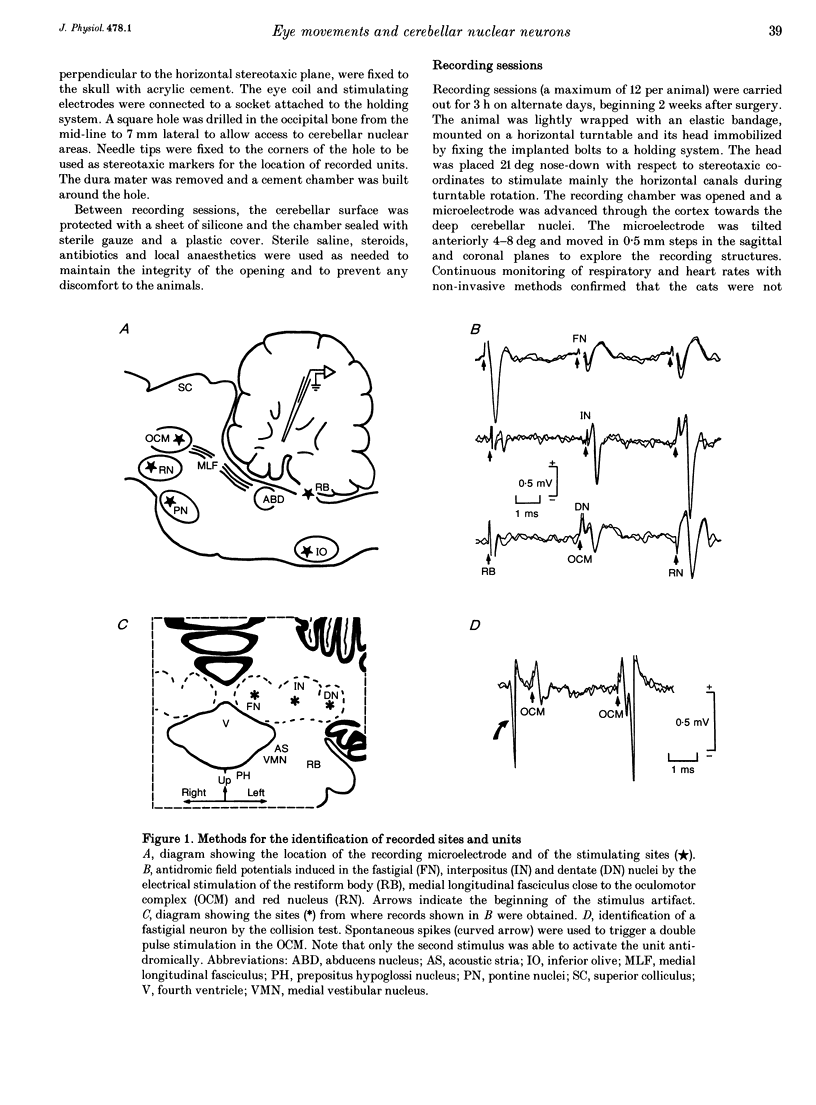



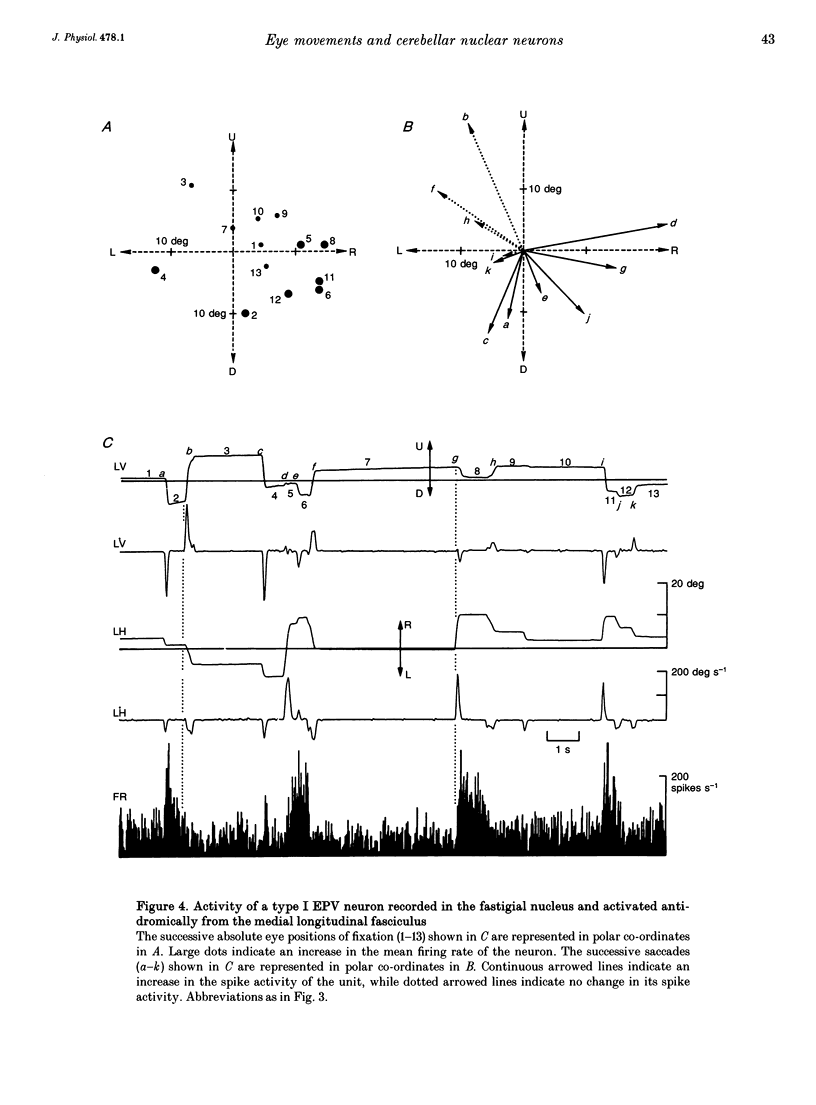


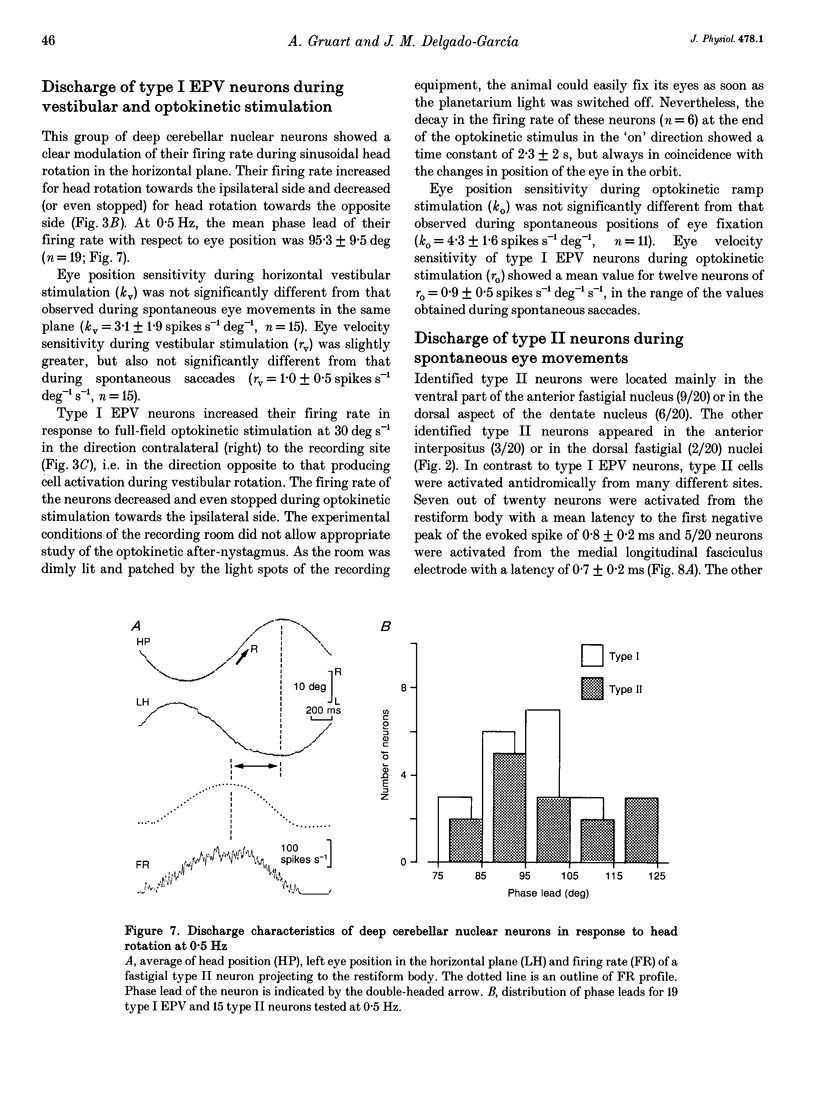
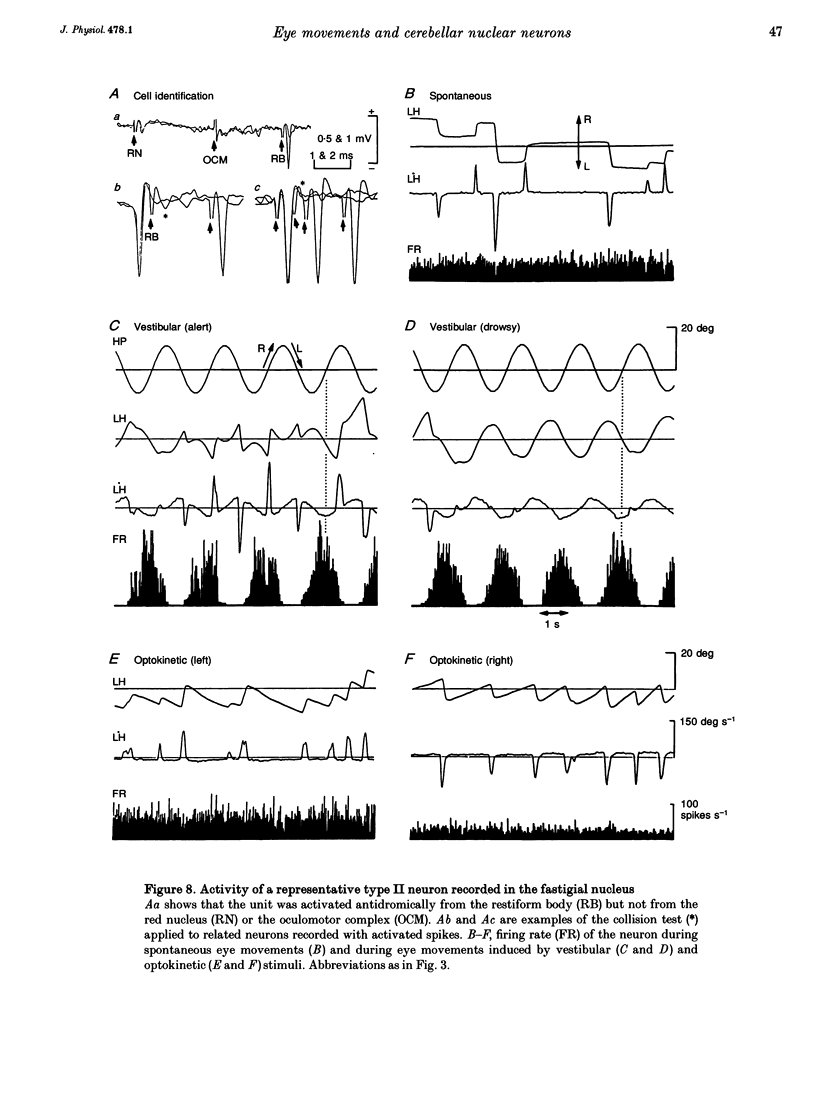


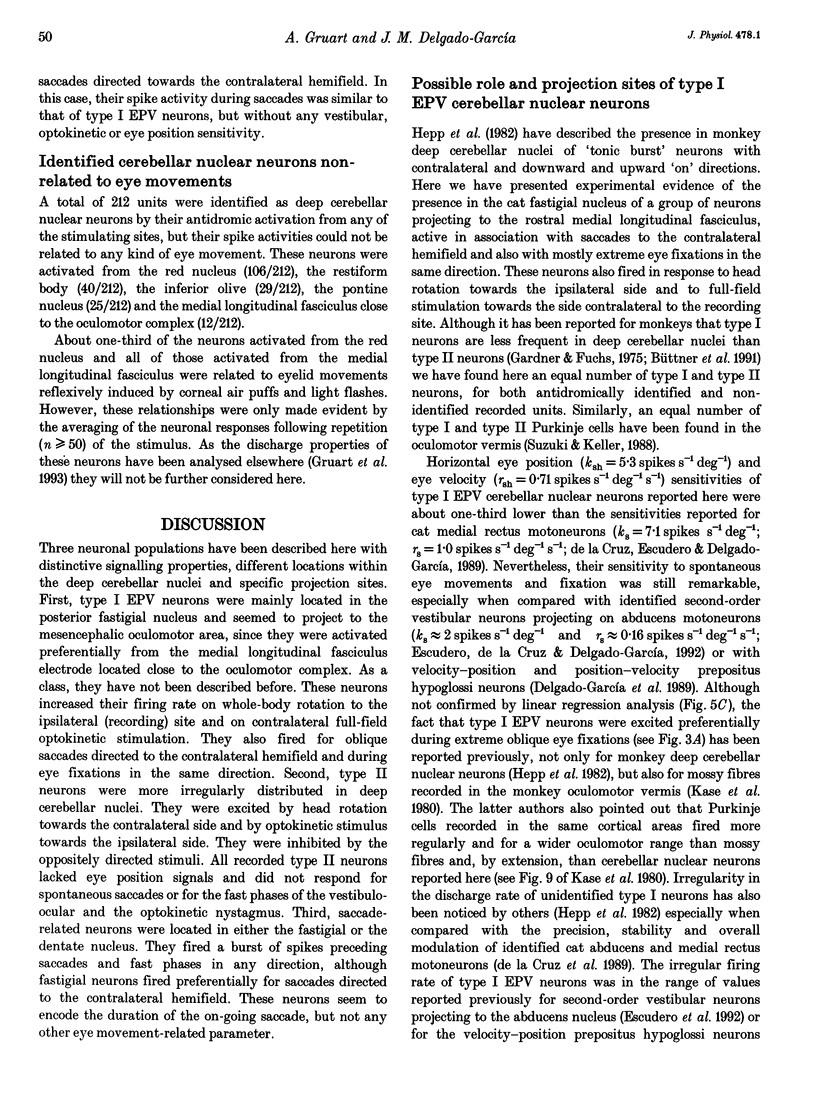
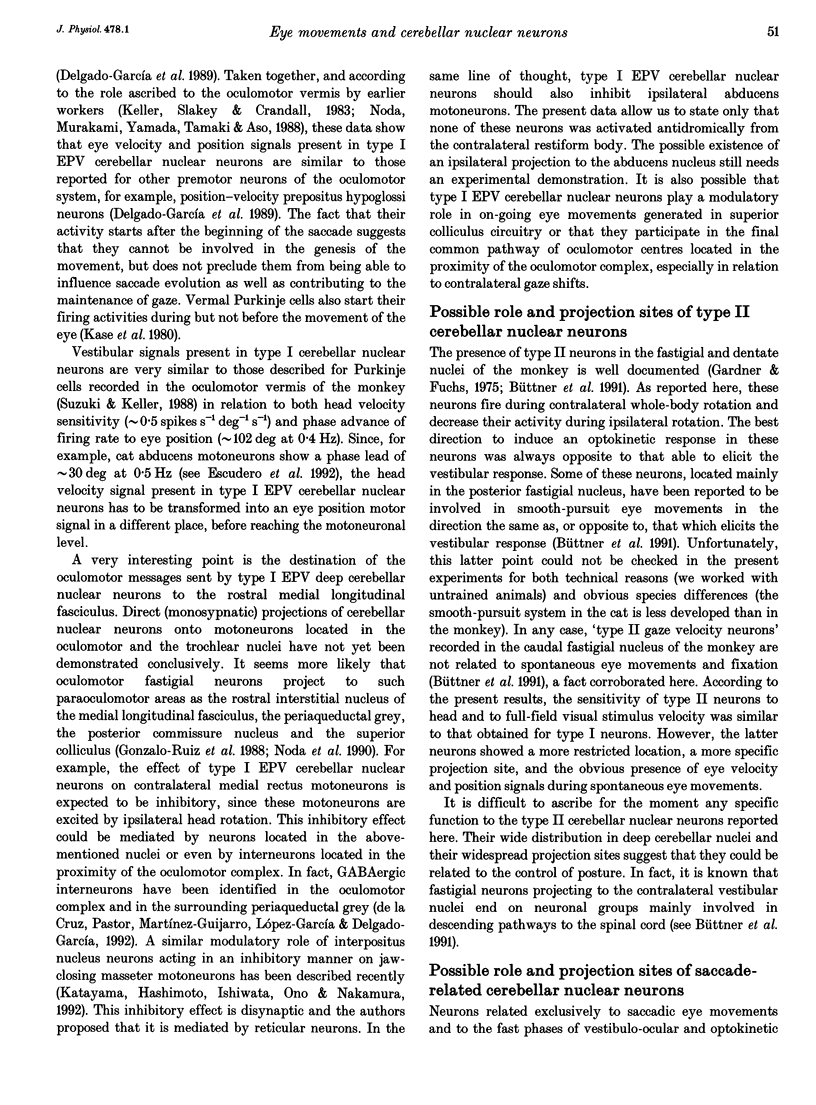



Selected References
These references are in PubMed. This may not be the complete list of references from this article.
- Armstrong D. M., Schild R. F. An investigation of the cerebellar cortico-nuclear projections in the rat using an autoradiographic tracing method. I. Projections from the vermis. Brain Res. 1978 Feb 3;141(1):1–19. doi: 10.1016/0006-8993(78)90613-3. [DOI] [PubMed] [Google Scholar]
- Aschoff J. C., Cohen B. Changes in saccadic eye movements produced by cerebellar cortical lesions. Exp Neurol. 1971 Aug;32(2):123–133. doi: 10.1016/0014-4886(71)90056-2. [DOI] [PubMed] [Google Scholar]
- Baker R., Precht W., Llinas R. Mossy and climbing fiber projections of extraocular muscle afferents to the cerebellum. Brain Res. 1972 Mar 24;38(2):440–445. doi: 10.1016/0006-8993(72)90728-7. [DOI] [PubMed] [Google Scholar]
- Blanks R. H. Cerebellum. Rev Oculomot Res. 1988;2:225–272. [PubMed] [Google Scholar]
- Büttner U., Fuchs A. F., Markert-Schwab G., Buckmaster P. Fastigial nucleus activity in the alert monkey during slow eye and head movements. J Neurophysiol. 1991 Jun;65(6):1360–1371. doi: 10.1152/jn.1991.65.6.1360. [DOI] [PubMed] [Google Scholar]
- Büttner U., Waespe W. Purkinje cell activity in the primate flocculus during optokinetic stimulation, smooth pursuit eye movements and VOR-suppression. Exp Brain Res. 1984;55(1):97–104. doi: 10.1007/BF00240502. [DOI] [PubMed] [Google Scholar]
- DUENSING F., SCHAEFER K. P. Die Aktivität einzelner Neurone im Bereich der Vestibulariskerne bei Horizontalbeschleunigungen unter besonderer Berücksichtigung des vestibulären Nystagmus. Arch Psychiatr Nervenkr Z Gesamte Neurol Psychiatr. 1958;198(2):225–252. doi: 10.1007/BF00941383. [DOI] [PubMed] [Google Scholar]
- De La Cruz R. R., Escudero M., Delgado-García J. M. Behaviour of Medial Rectus Motoneurons in the Alert Cat. Eur J Neurosci. 1989 May;1(3):288–295. doi: 10.1111/j.1460-9568.1989.tb00796.x. [DOI] [PubMed] [Google Scholar]
- Delgado-García J. M., Vidal P. P., Gómez C., Berthoz A. A neurophysiological study of prepositus hypoglossi neurons projecting to oculomotor and preoculomotor nuclei in the alert cat. Neuroscience. 1989;29(2):291–307. doi: 10.1016/0306-4522(89)90058-4. [DOI] [PubMed] [Google Scholar]
- Escudero M., de la Cruz R. R., Delgado-García J. M. A physiological study of vestibular and prepositus hypoglossi neurones projecting to the abducens nucleus in the alert cat. J Physiol. 1992 Dec;458:539–560. doi: 10.1113/jphysiol.1992.sp019433. [DOI] [PMC free article] [PubMed] [Google Scholar]
- Gardner E. P., Fuchs A. F. Single-unit responses to natural vestibular stimuli and eye movements in deep cerebellar nuclei of the alert rhesus monkey. J Neurophysiol. 1975 May;38(3):627–649. doi: 10.1152/jn.1975.38.3.627. [DOI] [PubMed] [Google Scholar]
- Gonzalo-Ruiz A., Leichnetz G. R., Smith D. J. Origin of cerebellar projections to the region of the oculomotor complex, medial pontine reticular formation, and superior colliculus in New World monkeys: a retrograde horseradish peroxidase study. J Comp Neurol. 1988 Feb 22;268(4):508–526. doi: 10.1002/cne.902680404. [DOI] [PubMed] [Google Scholar]
- Gruart A., Zamora C., Delgado-García J. M. Response diversity of pontine and deep cerebellar nuclear neurons to air puff stimulation of the eye in the alert cat. Neurosci Lett. 1993 Apr 2;152(1-2):87–90. doi: 10.1016/0304-3940(93)90490-c. [DOI] [PubMed] [Google Scholar]
- Hepp K., Henn V., Jaeger J. Eye movement related neurons in the cerebellar nuclei of the alert monkey. Exp Brain Res. 1982;45(1-2):253–264. doi: 10.1007/BF00235785. [DOI] [PubMed] [Google Scholar]
- Ito M., Yoshida M., Obata K., Kawai N., Udo M. Inhibitory control of intracerebellar nuclei by the purkinje cell axons. Exp Brain Res. 1970;10(1):64–80. doi: 10.1007/BF00340519. [DOI] [PubMed] [Google Scholar]
- Kano M., Kano M. S., Maekawa K. Optokinetic response of simple spikes of Purkinje cells in the cerebellar flocculus and nodulus of the pigmented rabbit. Exp Brain Res. 1991;87(3):484–496. doi: 10.1007/BF00227074. [DOI] [PubMed] [Google Scholar]
- Kase M., Miller D. C., Noda H. Discharges of Purkinje cells and mossy fibres in the cerebellar vermis of the monkey during saccadic eye movements and fixation. J Physiol. 1980 Mar;300:539–555. doi: 10.1113/jphysiol.1980.sp013178. [DOI] [PMC free article] [PubMed] [Google Scholar]
- Katayama T., Hashimoto N., Ishiwata Y., Ono T., Nakamura Y. Control of trigeminal motoneurons from the cerebellar interpositus nucleus of the guinea pig. J Neurophysiol. 1992 Jun;67(6):1528–1542. doi: 10.1152/jn.1992.67.6.1528. [DOI] [PubMed] [Google Scholar]
- Keller E. L., Slakey D. P., Crandall W. F. Microstimulation of the primate cerebellar vermis during saccadic eye movements. Brain Res. 1983 Dec 12;288(1-2):131–143. doi: 10.1016/0006-8993(83)90087-2. [DOI] [PubMed] [Google Scholar]
- Leiva J., Saavedra H. Eye movement-related neurons in the red nucleus. Neurosci Lett. 1990 Oct 2;118(1):37–40. doi: 10.1016/0304-3940(90)90243-3. [DOI] [PubMed] [Google Scholar]
- Lisberger S. G., Fuchs A. F. Role of primate flocculus during rapid behavioral modification of vestibuloocular reflex. II. Mossy fiber firing patterns during horizontal head rotation and eye movement. J Neurophysiol. 1978 May;41(3):764–777. doi: 10.1152/jn.1978.41.3.764. [DOI] [PubMed] [Google Scholar]
- Llinás R., Mühlethaler M. Electrophysiology of guinea-pig cerebellar nuclear cells in the in vitro brain stem-cerebellar preparation. J Physiol. 1988 Oct;404:241–258. doi: 10.1113/jphysiol.1988.sp017288. [DOI] [PMC free article] [PubMed] [Google Scholar]
- Mano N., Ito Y., Shibutani H. Saccade-related Purkinje cells in the cerebellar hemispheres of the monkey. Exp Brain Res. 1991;84(3):465–470. doi: 10.1007/BF00230957. [DOI] [PubMed] [Google Scholar]
- McCrea R. A., Bishop G. A., Kitai S. T. Morphological and electrophysiological characteristics of projection neurons in the nucleus interpositus of the cat cerebellum. J Comp Neurol. 1978 Sep 15;181(2):397–419. doi: 10.1002/cne.901810210. [DOI] [PubMed] [Google Scholar]
- Noda H., Mikami A. Discharges of neurons in the dorsal paraflocculus of monkeys during eye movements and visual stimulation. J Neurophysiol. 1986 Oct;56(4):1129–1146. doi: 10.1152/jn.1986.56.4.1129. [DOI] [PubMed] [Google Scholar]
- Noda H., Murakami S., Yamada J., Tamada J., Tamaki Y., Aso T. Saccadic eye movements evoked by microstimulation of the fastigial nucleus of macaque monkeys. J Neurophysiol. 1988 Sep;60(3):1036–1052. doi: 10.1152/jn.1988.60.3.1036. [DOI] [PubMed] [Google Scholar]
- Noda H., Sugita S., Ikeda Y. Afferent and efferent connections of the oculomotor region of the fastigial nucleus in the macaque monkey. J Comp Neurol. 1990 Dec 8;302(2):330–348. doi: 10.1002/cne.903020211. [DOI] [PubMed] [Google Scholar]
- Ohtsuka K., Noda H. Saccadic burst neurons in the oculomotor region of the fastigial nucleus of macaque monkeys. J Neurophysiol. 1991 Jun;65(6):1422–1434. doi: 10.1152/jn.1991.65.6.1422. [DOI] [PubMed] [Google Scholar]
- Ohtsuka K., Noda H. The effect of microstimulation of the oculomotor vermis on discharges of fastigial neurons and visually-directed saccades in macaques. Neurosci Res. 1991 May;10(4):290–295. doi: 10.1016/0168-0102(91)90086-e. [DOI] [PubMed] [Google Scholar]
- Robinson D. A. Oculomotor unit behavior in the monkey. J Neurophysiol. 1970 May;33(3):393–403. doi: 10.1152/jn.1970.33.3.393. [DOI] [PubMed] [Google Scholar]
- Røste G. K., Dietrichs E. The feline oculomotor nucleus: morphological subdivisions and projection to the cerebellar cortex and nuclei. Anat Embryol (Berl) 1988;178(1):67–75. doi: 10.1007/BF00305016. [DOI] [PubMed] [Google Scholar]
- Sato Y., Kawasaki T. Operational unit responsible for plane-specific control of eye movement by cerebellar flocculus in cat. J Neurophysiol. 1990 Aug;64(2):551–564. doi: 10.1152/jn.1990.64.2.551. [DOI] [PubMed] [Google Scholar]
- Shinoda Y., Sugiuchi Y., Futami T., Izawa R. Axon collaterals of mossy fibers from the pontine nucleus in the cerebellar dentate nucleus. J Neurophysiol. 1992 Mar;67(3):547–560. doi: 10.1152/jn.1992.67.3.547. [DOI] [PubMed] [Google Scholar]
- Suzuki D. A., Keller E. L. The role of the posterior vermis of monkey cerebellum in smooth-pursuit eye movement control. I. Eye and head movement-related activity. J Neurophysiol. 1988 Jan;59(1):1–18. doi: 10.1152/jn.1988.59.1.1. [DOI] [PubMed] [Google Scholar]
- Suzuki D. A., Noda H., Kase M. Visual and pursuit eye movement-related activity in posterior vermis of monkey cerebellum. J Neurophysiol. 1981 Nov;46(5):1120–1139. doi: 10.1152/jn.1981.46.5.1120. [DOI] [PubMed] [Google Scholar]
- Yamada J., Noda H. Afferent and efferent connections of the oculomotor cerebellar vermis in the macaque monkey. J Comp Neurol. 1987 Nov 8;265(2):224–241. doi: 10.1002/cne.902650207. [DOI] [PubMed] [Google Scholar]
- Zee D. S., Yamazaki A., Butler P. H., Gücer G. Effects of ablation of flocculus and paraflocculus of eye movements in primate. J Neurophysiol. 1981 Oct;46(4):878–899. doi: 10.1152/jn.1981.46.4.878. [DOI] [PubMed] [Google Scholar]
- de la Cruz R. R., Pastor A. M., Martínez-Guijarro F. J., López-García C., Delgado-García J. M. Role of GABA in the extraocular motor nuclei of the cat: a postembedding immunocytochemical study. Neuroscience. 1992 Dec;51(4):911–929. doi: 10.1016/0306-4522(92)90529-b. [DOI] [PubMed] [Google Scholar]


